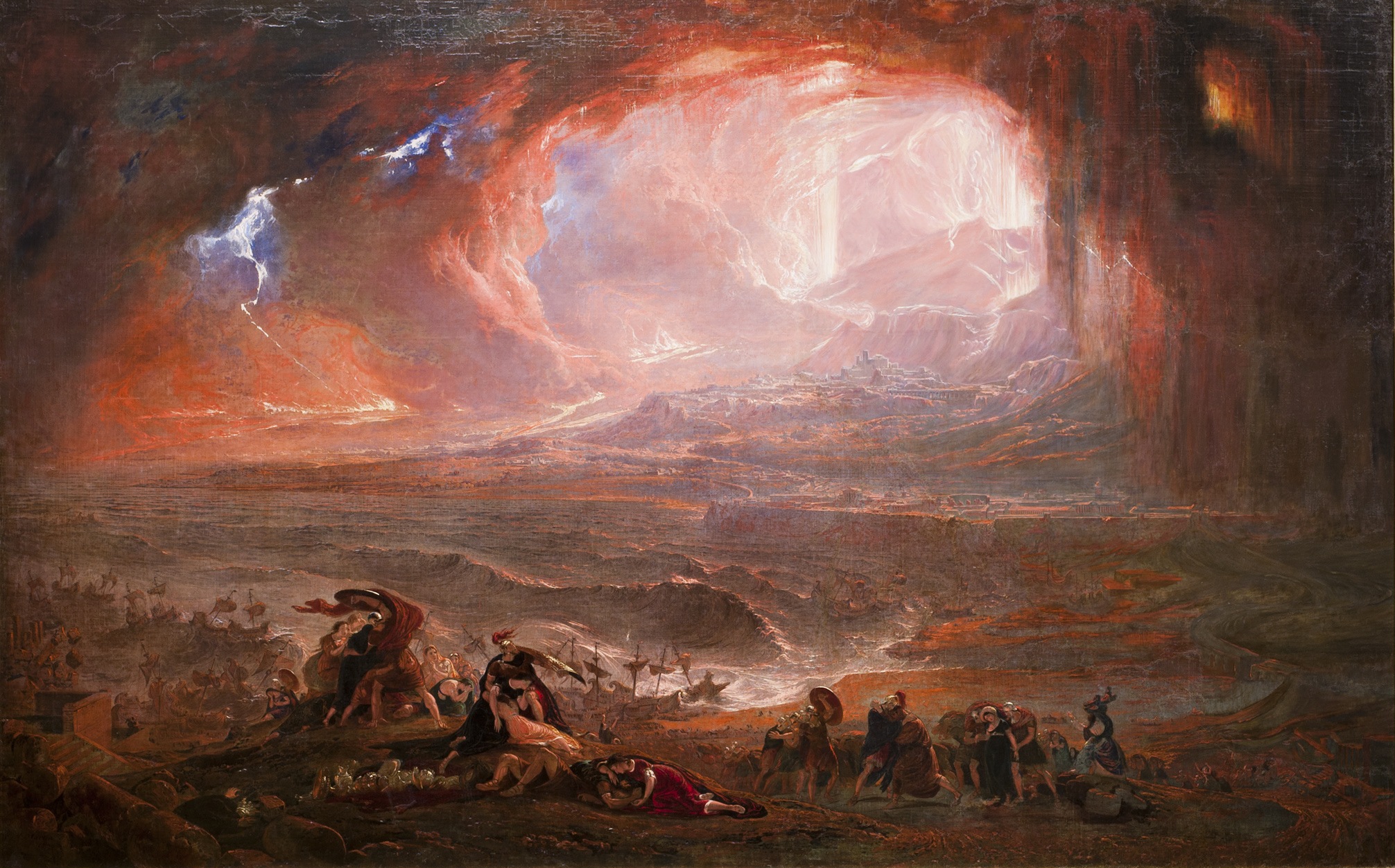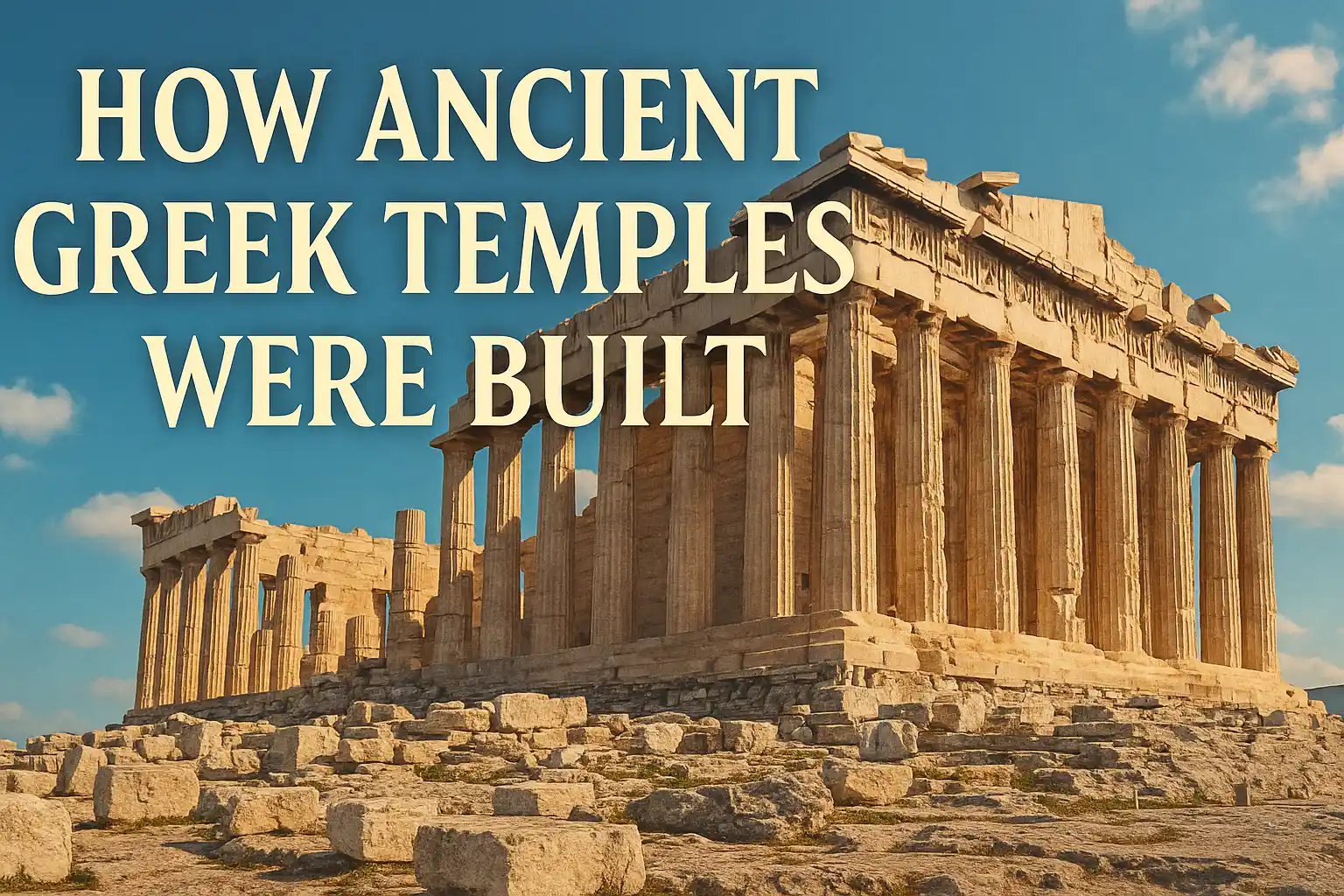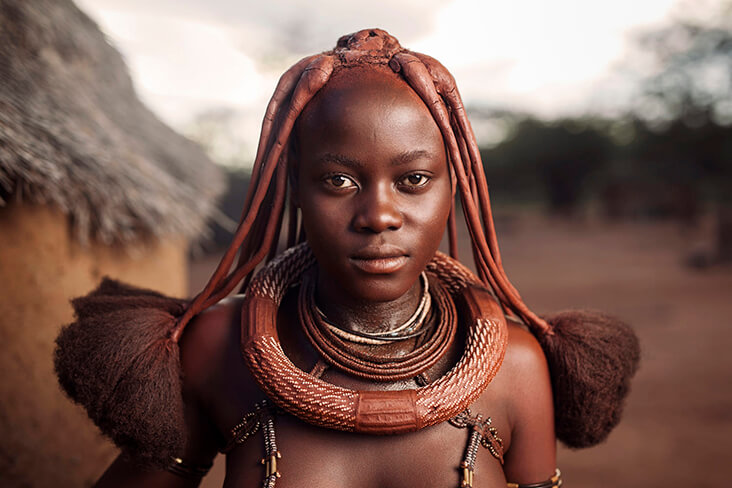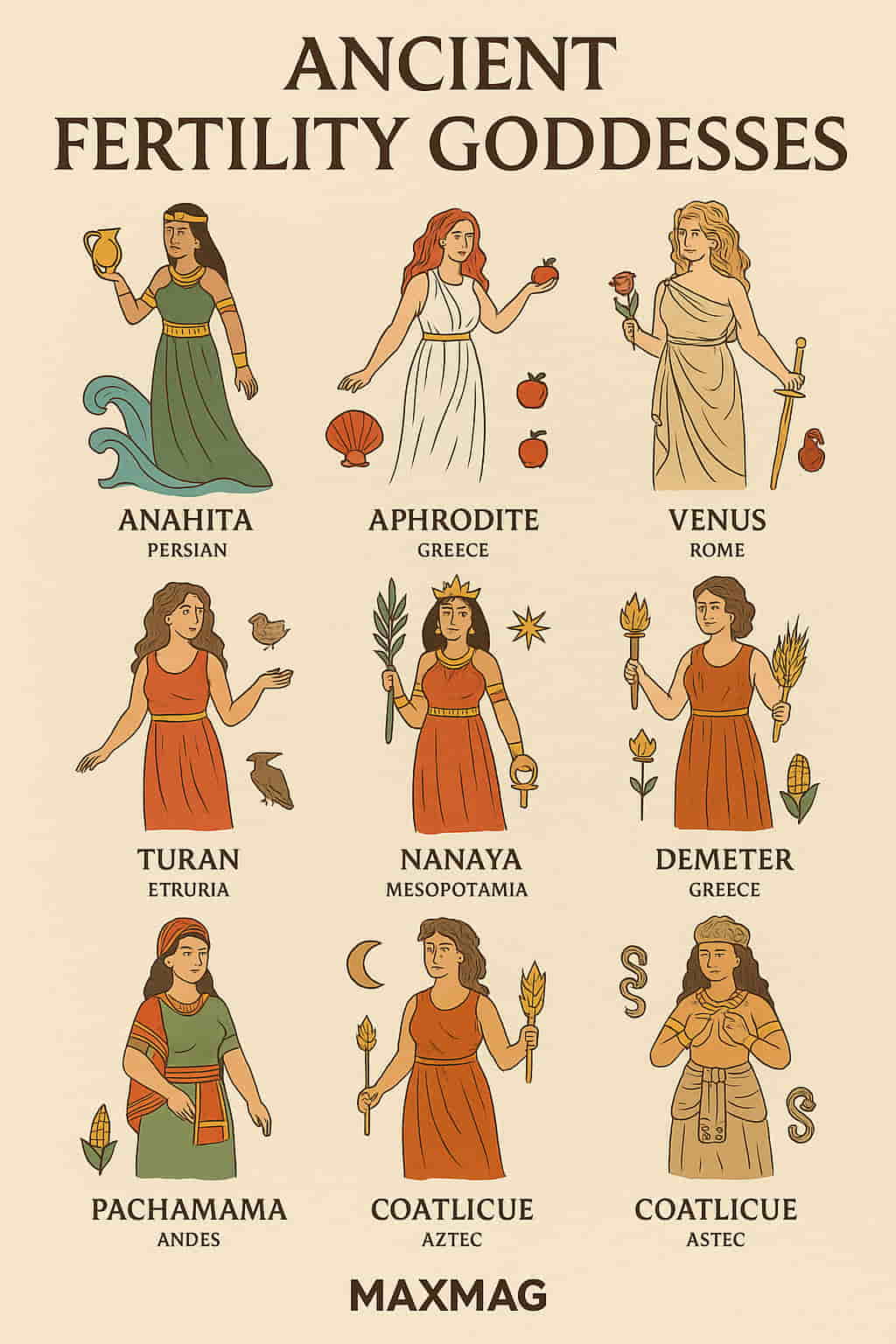
Across thousands of years and continents, the ancient fertility goddesses meaning has been a powerful symbol of human existence, reflecting humanity’s deep connection to nature, reproduction, love, and transformation. These goddesses were worshipped not only as spiritual figures but also as embodiments of the life force that drives creation and renewal.
Ancient civilizations—Mesopotamian, Egyptian, Greek, Persian, Roman, and beyond—turned to these divine feminine figures to explain the mysteries of birth, agricultural cycles, sexuality, and even death and rebirth. Whether through water rituals, temple offerings, or festivals of abundance, the presence of fertility goddesses marked key transitions in both personal life and collective culture.
In this expanded journey, we explore not only the most celebrated fertility goddesses but also lesser-known figures who played crucial roles in the spiritual and societal narratives of their time.
Anahita: The Persian Empress of Fertility, Healing, and War
In ancient Persia, Anahita was revered as a multifaceted goddess overseeing water, fertility, wisdom, and protection in war. Unlike many fertility goddesses confined to nurturing roles, Anahita stood as a guardian of both life and strength. Her dual nature made her especially significant in Zoroastrianism, where water represented purification, sustenance, and the sacred feminine.
Temples dedicated to Anahita once dotted the Iranian plateau. These temples often stood near rivers or springs, with rituals involving offerings of milk, flowers, and sometimes small sacrifices. Women in labor would pray to Anahita for safe delivery, and soldiers honored her before battle, linking fertility with survival.
Her enduring legacy is noted in both Avesta texts and Greco-Roman sources. For more on Anahita’s legacy, you can explore The Ancient History Encyclopedia.
Anuket: Nile Goddess and Mother of Nourishment
In ancient Egypt, the Nile was more than a river—it was the artery of civilization. At the southern border, near Elephantine Island, the goddess Anuket watched over the first cataract of the Nile. As the daughter of Khnum and Satis, she was part of a divine triad that protected the Nile’s precious waters and controlled the annual flood.
Anuket’s name means “the Embracer,” reflecting the river’s embrace of the land, which brought fertility to Egypt’s crops. Her image appears in golden headdresses and carrying scepters, highlighting her royal and maternal essence. Pilgrims would toss coins and jewelry into the Nile during the Festival of Anuket, asking for fertility, healthy children, and good harvests.
To understand the significance of the Nile deities in Egyptian belief, visit The Oriental Institute.
Aphrodite: Love, Fertility, and Sacred Beauty in Greece
The Greek goddess Aphrodite is often remembered as the deity of romantic love and beauty, but her deeper role as a fertility goddess is equally significant. She governed not only sexual attraction but also reproduction, childbirth, and social harmony.
Her birth from the sea—according to Hesiod—links her to the eternal cycles of nature and rebirth. Temples to Aphrodite were centers of fertility rites, sacred prostitution (in earlier periods), and rituals meant to ensure the city’s prosperity. In Cyprus, her oldest sanctuary at Paphos was considered a pilgrimage site for women seeking fertility blessings.
Aphrodite was often shown with symbols of fertility—doves, pomegranates, roses—while her consort Ares and son Eros further wove together themes of passion, procreation, and cosmic balance.
For classical interpretations, consult Harvard’s Center for Hellenic Studies.
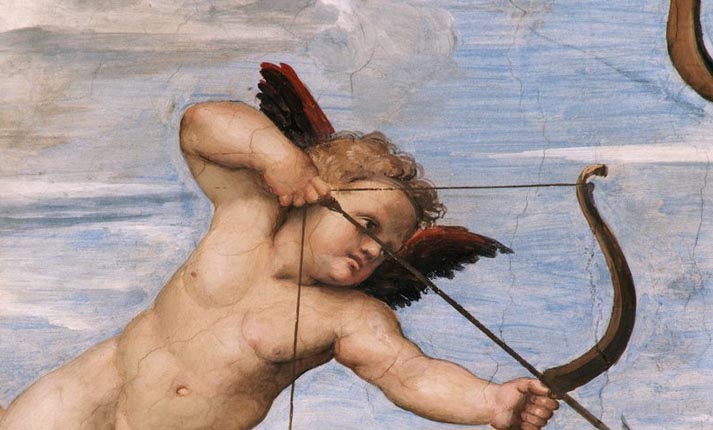
Eros and Psyche: Love’s Power to Transform and Create
While Aphrodite’s role as mother of Eros (Cupid) is widely known, the myth of Eros and Psyche adds a profound layer to the fertility theme. Their union reflects not only erotic desire but also the soul’s journey toward wholeness and creation.
Eros, once a primordial god in early cosmology, was later seen as the force that united elements to create life. Through Psyche—whose name means “soul”—this myth transforms love into a deeply spiritual and creative experience, reaffirming the ancient fertility goddesses meaning in emotional and metaphysical dimensions.
Venus: Roman Icon of Power and Procreation
The Roman goddess Venus, while born from Aphrodite’s legacy, was elevated into a matriarchal figure. She was not just a goddess of love, but the divine ancestor of Rome through her son Aeneas. In this way, Venus symbolized political legitimacy and generational fertility.
The temple of Venus Genetrix in the Forum of Caesar reflected her status as a mother of the Roman people. Offerings to her often came during Veneralia, a festival where women bathed her statue and asked for romantic and reproductive blessings.
Venus was depicted with wheat, roses, and apples—symbols of abundance. Her influence extended beyond romance and into the civic, agricultural, and dynastic spheres of Rome.
Turan: Etruscan Spirit of Spring, Love, and Freedom
Turan, goddess of love and fertility in Etruscan religion, was a more playful, youthful counterpart to Aphrodite or Venus. Her connection to spring, birds, and gardens reflects a uniquely gentle aspect of feminine vitality.
She was depicted as a winged young woman, often accompanied by the god Laran (war) and the god Atunis (life and death). Their love triangle expressed the Etruscan view of life’s fragility and passion. Fertility rituals in her honor included song, dance, and symbolic planting, reflecting themes of natural renewal.
To explore Etruscan religious life, you can check The Getty Museum’s ancient collections.
Nanaya: Mesopotamian Embodiment of Desire and Creation
In Mesopotamian civilization, fertility goddesses held critical positions in urban religious life. Among them, Nanaya was a powerful symbol of sensuality, beauty, and reproductive power. She was worshiped primarily in Uruk and Babylon, often alongside Ishtar and Inanna.
Nanaya’s rites included music, incense, and processions. Her hymns celebrated not only love but also the sanctity of union between man and woman, city and land, gods and people. Her influence extended to Elamite and Persian territories, showcasing the spread of divine feminine worship through conquest and trade.
Modern interpretations often liken Nanaya to a force of liberation for women, reclaiming sensuality as sacred.
Inanna and Ishtar: Celestial Queens of Life and Death
Inanna (Sumerian) and Ishtar (Akkadian) were perhaps the most dramatic expressions of the ancient fertility goddesses meaning in all of the Near East. These goddesses governed war, love, childbirth, and even death. Their myth of descent into the underworld—where they die and are reborn—was symbolic of both seasonal cycles and human transformation.
Their temples, called Eanna, were architectural marvels filled with priestesses, musicians, and rituals of sacred marriage. Offerings included pomegranates, dates, and perfumes—luxuries representing prosperity and fertility.
The duality of creation and destruction in their character suggests that fertility was not merely about life, but about embracing change and rebirth as sacred processes.

Demeter and Persephone: Agricultural Fertility and the Seasons
The Greek goddesses Demeter and her daughter Persephone embodied another key layer of fertility: the link between agriculture and human life. Demeter, goddess of the harvest, controlled the earth’s productivity, while Persephone’s annual descent into Hades and return marked the changing seasons.
The Eleusinian Mysteries, a set of initiation rituals in their honor, focused on rebirth, the afterlife, and the miracle of life’s regeneration. Women, especially, found deep spiritual and social meaning in these rites, which empowered them beyond patriarchal boundaries.
For reliable information on Demeter’s role, see Theoi Project or institutional archives from Dartmouth College.
Shared Symbols of Fertility Goddesses
Throughout world mythologies, fertility goddesses share recurring themes and symbols that make their identification across time easier:
-
Water: as the source of life (Anahita, Anuket)
-
Flowers & Fruit: especially pomegranates, apples, and roses (Aphrodite, Ishtar)
-
Birds: particularly doves, swans, or geese (Turan, Venus)
-
Serpents: symbols of transformation, menstruation, and rebirth
-
Moon: governing the female cycle and divine femininity
These motifs help interpret the ancient fertility goddesses meaning as a multi-layered archetype reflecting emotional, biological, spiritual, and environmental dimensions of life.
Fertility Goddesses in Other Cultures
Shakti and Parvati (Hinduism)
In Hindu mythology, fertility is strongly associated with the goddess Parvati, consort of Shiva and mother of Ganesha. As an embodiment of Shakti (divine feminine energy), she reflects both sensual love and maternal protection.
Pachamama (Andean Civilization)
The earth goddess Pachamama was worshiped by pre-Incan and Incan societies. Offerings were buried in the soil to ensure good harvests and family health, reinforcing her role as a living, breathing planet-mother.
Coatlicue (Aztec)
The terrifying but revered Coatlicue, whose skirt was made of serpents, gave birth to gods and guided the cosmic balance. She reminded believers that life and death were two sides of the same coin.
Modern Spiritual Revival and Cultural Influence
Today, goddess-centered spirituality is experiencing a revival. Movements like Wicca, Goddess Spirituality, and feminist theology are reclaiming these figures as empowering symbols for women and nature.
Books like The Chalice and the Blade by Riane Eisler and Women Who Run with the Wolves by Clarissa Pinkola Estés explore how goddess myths continue to shape modern identity. These figures are appearing in art therapy, meditation, environmental movements, and even reproductive justice narratives.
To explore goddess worship today, visit The Fellowship of Isis, an inclusive global organization.
The Eternal Meaning of Fertility Goddesses
The ancient fertility goddesses meaning lies in their eternal relevance. They serve as mirrors through which humanity has understood love, birth, growth, and death. Whether invoked by name or symbol, they stand as testaments to the sacredness of life and the enduring power of the feminine.
Their archetypes live on in our languages, rituals, stories, and dreams. And perhaps that’s their greatest gift: a timeless reminder that creation—be it of life, art, love, or legacy—is divine.
❓ FAQ: Ancient Fertility Goddesses Meaning
1. What defines a fertility goddess?
Fertility goddesses are divine figures associated with reproduction, birth, agriculture, love, and life cycles.
2. Which is the oldest known fertility goddess?
Possibly Inanna of Sumer, dating back to 4000 BCE. She evolved into Ishtar in Akkadian culture.
3. Are fertility goddesses still worshiped today?
Yes. In Wicca, neo-paganism, and some Hindu traditions, they are actively honored.
4. How do fertility goddesses relate to nature?
They often personify natural elements—water, earth, moon, vegetation—emphasizing the link between human and ecological fertility.
5. Are male fertility gods as common?
They exist (e.g., Priapus, Osiris), but female deities are more prevalent due to their symbolic association with childbirth and nature.
6. What rituals were performed in their honor?
Offerings, dances, sacred sexuality, planting ceremonies, and festivals during key seasonal changes were common.
7. Do fertility goddesses appear in art today?
Yes. From paintings and sculptures to tarot decks and digital art, they remain enduring muses.

